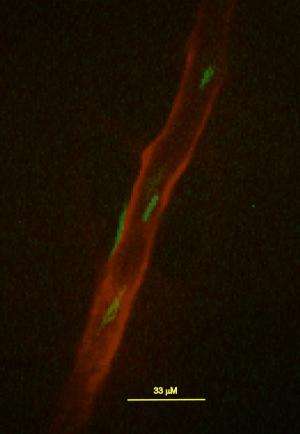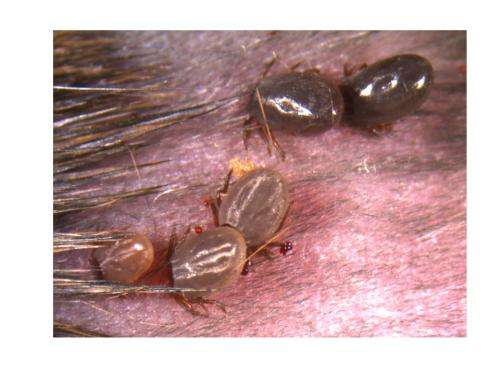Essential factor for Lyme disease transmission identified

Borrelia burgdorferi, the bacterium that causes Lyme disease, hitchhikes in ticks for dissemination to mammalian hosts—including humans. An article in the 19 December issue of PLOS Pathogens identifies HrpA, an RNA helicase, as a crucial player in the transmission from ticks to mammals.
George Chaconas, from the University of Calgary, Canada, and a member of the university's Snyder Institute for Chronic Diseases, and colleagues had previously identified HrpA as a modulator of B. burgdorferi protein expression. For this study, Chaconas' group joined forces with Justin Radolf and Melissa Caimano from the University of Connecticut Health Center, USA, to analyze the molecular function of the HrpA protein and further explore its role in the bacterium's complicated life cycle, in particular for transmission of the pathogen.
Its DNA sequence suggests that HrpA is an RNA helicase, a protein that can harvest energy from the cell's stores, use it to unwind RNA, and so regulate translation of RNA into protein. Most bacteria have several putative helicases, including one from the HrpA family, but nothing was known about the actual HrpA function from other species. HrpA is the only putative RNA helicase in B. burgdorferi, and the scientists found that it indeed possesses the multiple activities characteristic of a helicase: it can bind to RNA and use its ATPase activity to harvest energy, which in turn is used to unwind the RNA strand. They also showed that these activities are involved in the regulation of target RNAs.

When the scientists tested whether mutant B. burgdorferi that lacked the hrpA gene could infect mice, they found that the mutant bacteria could not. For this experiment, the scientists injected normal or mutant bacteria directly into mice, and subsequently tested mouse blood, skin, bladder, or joint tissue for the presence of bacteria. Normal bacteria could be recovered from all tissues after a week and up to 4 weeks post injection, but mutant bacteria were undetectable even after one week, suggesting that they were unable to survive or multiply in the mammalian host.
HrpA-deficient bacteria were also unable to infect mice using the natural route, i.e. via a bite from an infected tick. This was not because the mutant bacteria were unable to grow or survive in the ticks. Rather the mutants could not exit the tick midgut or enter the salivary glands, where Borrelia needs to be for successful transmission during feeding; even right after the engorged ticks fell off, mutant bacteria were not detectable in the mouse skin around the attachment site.
The authors say, "We now know that HrpA is involved in both parts of the B. burgdorferi lifecycle: animal infection and tick transmission, making it a very important protein in B. burgdorferi gene regulation and establishing gene regulation through an RNA helicase as an important regulatory pathway in the Lyme spirochete."
More information: Salman-Dilgimen A, Hardy P-O, Radolf JD, Caimano MJ, Chaconas G (2013) HrpA, an RNA Helicase Involved in RNA Processing, Is Required for Mouse Infectivity and Tick Transmission of the Lyme Disease Spirochete. PLoS Pathog 9(12): e1003841. DOI: 10.1371/journal.ppat.1003841


















